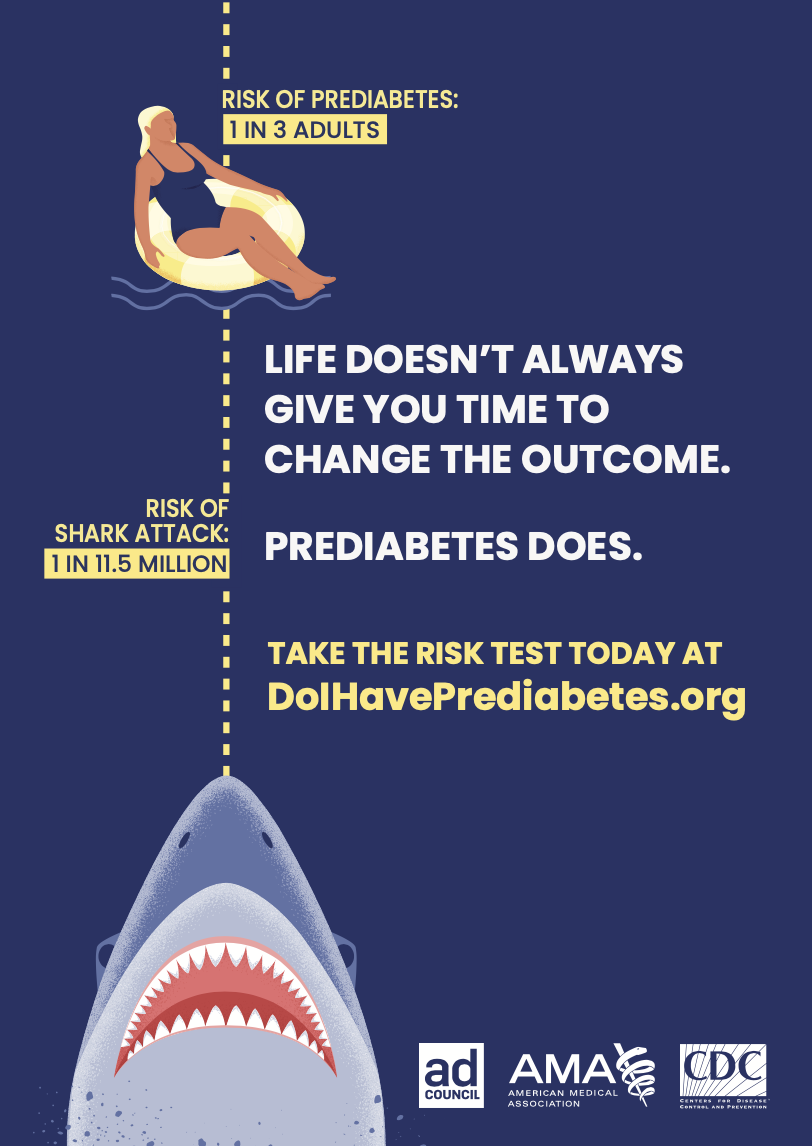Prediabetes
‹View Table of Contents

When a person has prediabetes, their blood sugar levels are higher than normal but not high enough for a diabetes diagnosis. Prediabetes increases a person’s risk of developing type 2 diabetes, heart disease, and stroke. CDC estimates that 96 million—or more than 1 in 3—US adults 18 or older had prediabetes in 2019. This number includes over 37 million adults aged 45 to 64 and over 26 million adults 65 or older. A higher percentage of men (41.9%) had prediabetes than women (34.3%).10
There were no significant changes in prevalence of prediabetes from the time period of 2005–2008 to 2017–2020. About one-third of US adults had prediabetes over the entire period. Data show that the percentage of US adults with prediabetes who reported they had ever been notified by a health professional of their prediabetes status nearly tripled (from 6.5% to 17.4%) (Figure 8).10 Table 2 presents state-level percentages of US adults who had ever been notified that they have prediabetes in 2018–the most recent year for which state-level data is available.20
Figure 8. National Trends in Prevalence and Notification by a Health Professional of Prediabetes Among US Adults Aged 18 Years or Older, 2005–2008 to 2017–2020

Notes: Percentages are age-adjusted to the 2000 US Census standard population. Notification of prediabetes status was based on self-report and estimated only for adults with prediabetes. Prediabetes was defined as fasting plasma glucose values of 100–125 mg/dL or hemoglobin A1C values of 5.7%–6.4%. Time periods overlap and are moving averages, with two survey periods each. Figure adapted from CDC’s National Diabetes Statistics Report.
Data source: National Health and Nutrition Examination Survey, Centers for Disease Control and Prevention
| State or US Territory | Percentage | Comparison to the US Median |
|---|---|---|
| US Mediana | 8.8 | N/A |
| Alabama | 7.3 | |
| Alaska | 9.3 | |
| Arizona | 10.9 | |
| Arkansasb | 6.5 | |
| Californiac | 8.2 | |
| Coloradob | 9.7 | |
| Connecticut | 8.9 | |
| Delawareb | 9.8 | |
| District of Columbia | 11.6 | |
| Florida | 9.7 | |
| Georgia | 9.5 | |
| Guam | 11.0 | |
| Hawaii | 12.8 | |
| Idaho | 8.0 | |
| Illinoisd | 7.3 | |
| Indiana | 7.7 | |
| Iowa | 7.3 | |
| Kansas | 8.1 | |
| Kentucky | 9.5 | |
| Louisianab | 7.7 | |
| Maine | 8.0 | |
| Maryland | 10.6 | |
| Massachusetts | 8.5 | |
| Michiganb | 7.7 | |
| Minnesotab | 7.0 | |
| Mississippi | 6.6 | |
| Missouri | 7.5 | |
| Montanab | 6.2 | |
| Nebraskab | 5.5 | |
| Nevadab | 10.1 | |
| New Hampshireb | 7.0 | |
| New Jersey | 11.9 | |
| New Mexico | 10.7 | |
| New York | 9.0 | |
| North Carolina | 8.2 | |
| North Dakota | 6.6 | |
| Ohio | 8.0 | |
| Oklahoma | 8.8 | = |
| Oregon | 9.7 | |
| Pennsylvaniab | 6.3 | |
| Puerto Rico | 10.8 | |
| Rhode Islandb | 6.5 | |
| South Carolina | 8.8 | = |
| South Dakota | 6.6 | |
| Tennessee | 8.6 | |
| Texas | 9.5 | |
| Utah | 8.8 | = |
| Vermontb | 5.5 | |
| US Virgin Islandsd | 10.8 | |
| Virginia | 9.4 | |
| Washington | 7.4 | |
| West Virginia | 8.9 | |
| Wisconsin | 7.7 | |
| Wyoming | 6.8 |
Note: Percentages are age-adjusted to the 2000 US Census standard population. Up arrows indicate higher percentage or rate than the US median. Down arrows indicate lower percentage or rate. An equal to symbol indicates the state percentage or rate is the same as the US median. N/A means not applicable.
Data sources: United States Diabetes Surveillance System and Behavioral Risk Factor Surveillance System, Centers for Disease Control and Prevention.
a State median calculated with 2018 data only.
b Data from 13 states are from 2017 because 2018 data were not available.
c Data from 1 state are from 2014 because 2015–2018 data were not available.
d Data from 2 states are from 2016 because 2017 and 2018 data were not available.
The CDC-led Do I Have Prediabetes campaign increases awareness about prediabetes across the nation. Engaging public service announcements (PSAs) distributed through thousands of media outlets encourage people to take a 1-minute online test to learn their risk of prediabetes.
People with high scores are directed to see their doctor to confirm the result. The campaign website also provides links to CDC-recognized organizations that offer the National Diabetes Prevention Program (National DPP) lifestyle change program.
As of January 2022, the campaign had documented more than 4.3 million unique visitors to its website and about 3.9 million people have completed the prediabetes risk test. More than 178,000 people have visited the National DPP website to find a lifestyle change program. In addition, awareness of the term “prediabetes” increased from 50% in 2015 to 69% in 2021 among English-speaking adults 40 or older who have prediabetes or who are at increased risk of diabetes. Among Spanish speakers, awareness rose from 53% in 2015 to 86% in 2021.
